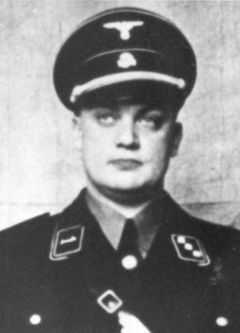Heinrich Schwarz
| Heinrich Schwarz | |
|---|---|
 | |
| Official portrait | |
| Personal details | |
| Born | 14 June 1906 München, German Empire |
| Died | 20 March 1947 (aged 40) Sandweier, Württemberg-Baden, Germany |
| Military service | |
| Allegiance | |
| Service/branch | |
| Rank | Hauptsturmführer, SS |
Heinrich Schwarz (June 14, 1906 – March 20, 1947) was an SS-Hauptsturmfűhrer and concentration camp officer who served as commandant of Auschwitz III-Monowitz in Nazi-occupied Poland and Natzweiler-Struthof in Alsace-Lorraine.
Schwarz was born in Munich on 14 June 1906 and originally worked as a book printer. He joined both the Nazi Party and the SS in November 1931. Following the outbreak of World War II, Schwarz served in the Waffen-SS until October 1940, when he was transferred to the SS-Concentration Camps Inspectorate. He was stationed at both the Mauthausen and Sachsenhausen concentration camps during 1940-1941.
Auschwitz concentration camp
In September 1941 Schwarz was transferred to Poland and posted to the administrative office of the Auschwitz concentration camp. His initial duties included working as an adjutant to the camp's commandant, Rudolf Höß. Schwarz also served as director of the camp's Work Assignment Department (Abt. IIIa) and held the position of Lagerführer for Auschwitz's central administration section. In November 1943, Höß was appointed leader of Office Group D in the SS Economic and Administrative Main Office in Berlin. Following his departure, the Auschwitz camp system was reorganized by the high command of the SS and divided into three semi-autonomous administrative units: Auschwitz I, Auschwitz II-Birkenau and the Auschwitz III-Monowitz labor camp. Under this new arrangement Schwarz was given command of Auschwitz III-Monowitz in December 1943.
Central to the role Schwarz played as commandant was the provision of slave-laborers to the nearby Buna Werke, a synthetic rubber factory owned by the German chemical company IG Farben. Other German corporations, such as Siemens and Krupp, also received slave labor from Monowitz. The brutal working conditions which prevailed at Monowitz during the period Schwarz served as commandant resulted in a large number of deaths among the inmate population, with estimates ranging between 10,000 to 25,000 prisoners who were believed to have died in both the labor camp itself and in the gas chambers located at neighboring Auschwitz-Birkenau.
Following the evacuation of Auschwitz complex on 18 January 1945, Schwarz was initially slated to take over command of the Mittelbau-Dora concentration camp and the associated V-weapons production facility of Mittelwerk, but was passed over for this post in favor of Richard Baer. He was instead appointed commandant of Natzweiler-Struthof in Alsace-Lorraine, where he oversaw the evacuation of the camp's inmates to Dachau during April and May 1945. Following the German defeat, Schwarz was convicted of war crimes by French occupation authorities in Rastatt. He was sentenced to death and subsequently shot by a firing squad near Baden-Baden on 20 March 1947.[1]
References
- ↑ Today's Best Military Writing: The Finest Articles on the Past, Present, and Future of the U.S. Military by Walter J. Boyne Publisher: Forge Books; 1st edition (August 26, 2004) Language: English ISBN 0-7653-0887-8 ISBN 9780765308870
| |||||||||||||||||||||||||||||||||||||||||||||||||||||||||||||||||||||||||||||||||||||||||||||||||||||||||||||||||||||||||||||||||||||||||
|